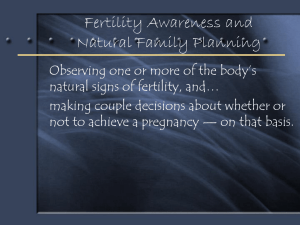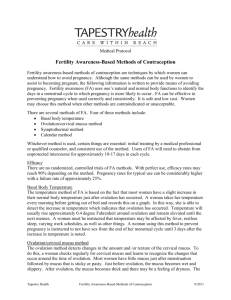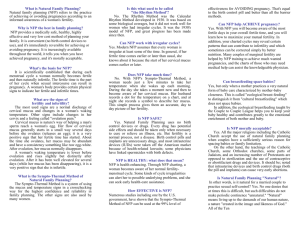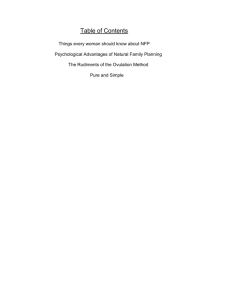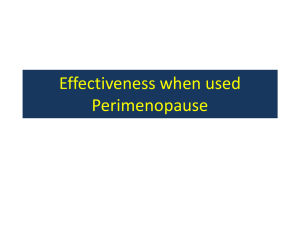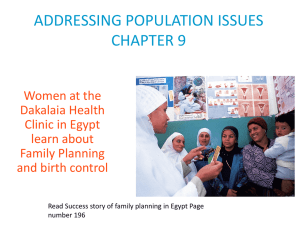Natural Family Planning
advertisement
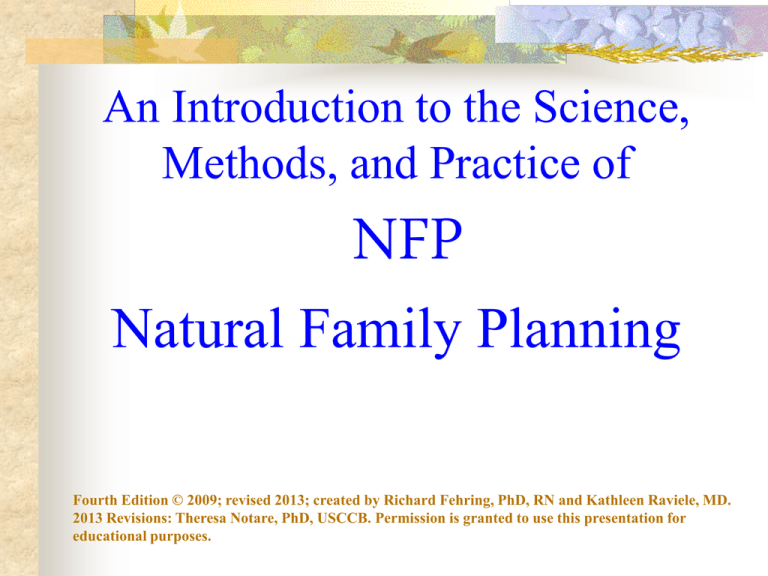
An Introduction to the Science, Methods, and Practice of NFP Natural Family Planning Fourth Edition © 2009; revised 2013; created by Richard Fehring, PhD, RN and Kathleen Raviele, MD. 2013 Revisions: Theresa Notare, PhD, USCCB. Permission is granted to use this presentation for educational purposes. Authors Richard J. Fehring, PhD, RN Director Marquette University Institute for Natural Family Planning Kathleen Raviele, MD, Ob/Gyn Private Practice Atlanta NFP Promoter, teacher, and medical consultant What do you think of when you hear the term Natural Family Planning? What do you hope for in your marriage? Objectives of Presentation Define Natural Family Planning (NFP) Describe how NFP works Discuss effectiveness of NFP methods Summarize the benefits of using NFP Definition of NFP Methods of monitoring and interpreting natural biological markers of fertility To help determine the fertile and infertile times of a woman’s menstrual cycle Information can be be used to achieve or avoid pregnancy NFP also means … Abstaining from intercourse and genital activity during fertile time of cycle if avoiding pregnancy Not using fertility contraception to interfere with Developing non-genital ways of expressing intimacy during the fertile times Being Open to Life METHODS OF NFP Calendar Rhythm Basal Body Temperature (BBT) Cervical Mucus (or Ovulation Method) Sympto-Thermal Method (STM) Hormonal Monitoring So – How Does NFP Work? Six Day Fertile Window A man and woman together are fertile for only 6 days. The day of ovulation when a egg is released. And the 5 days before ovulation! Phases of the Menstrual Cycle Fertile Phase Pre-Ovulatory Infertile Phase Ovulation Post-Ovulatory Infertile Phase Variability of the Cycle 1 2 3 4 5 6 7 8 9 10 11 12 13 14 15 16 17 18 19 20 21 22 23 24 25 26 27 28 29 Female Anatomy: Front View Ovary Fallopian Tube Vulva Uterus Cervix Vagina Female Cervix: Produces thin watery fertile mucus when stimulated by estrogen Sperm live in good mucus 3-5 days Produces thick mucus plug when stimulated by progesterone Female Ovary Ovum (Egg) In Ripe Follicle Developing Follicle Corpus Luteum Ovum Released at Ovulation NFP measures … Estrogen - secreted by the ovary’s follicle Stimulates cervical mucus production LH - secreted by the pituitary Stimulates ovulation Progesterone - secreted by the corpus luteum Raises basal body temperature Dries cervical mucus Natural Biological Signs of Fertility Changes in Resting Body Temp Changes in Cervical Mucus Changes in Female Hormones Note: some still use a Formula Female Menstrual Cycle Hormone Levels 28 Day Cycle LH FSH Estrogen Progesterone Day 5 10 14 22 25 The Beginning of Fertile Phase Presence of cervical mucus Rising levels of the hormone estrogen Shortest cycle minus 20 days; or day “8” Markers of Peak Fertility Cervical mucus – clear, stretchy, slippery Rise in basal body temperature LH hormone peaks The End of the Fertile Phase Peak in cervical mucus plus count of 3 Rise in temperature plus count of 3 Peak in LH plus count of 3 Longest cycle minus 10 days; or day “19” Cervical Mucus Cycle Beginning Peak Fertility End The BBT Chart 1 2 3 4 5 6 7 8 9 10 11 12 13 14 15 16 17 18 19 20 21 22 23 24 25 26 27 28 29 30 98 Biphasic Shift 97 Temps are low preovulatory Clearblue Fertility Monitor Low Fertility High Fertility Peak Fertility Basic Instructions for Achieving and Avoiding Pregnancy Achieve - Have intercourse during the fertile window! Avoid – Don’t have intercourse during the fertile window! NFP Efficacy Studies Terms The perfect or correct use unintended pregnancy rate refers to those pregnancies that occur when the method is used consistently and according to instructions. The typical use (or total) pregnancy rate includes the combination of unintended pregnancies when the methods are followed correctly and the unintended pregnancies that occur when users of the method do not always follow the instructions of the method correctly. Effectiveness of NFP* Single Index Methods Multiple Indexed Methods Perfect Use - 97% Perfect Use - 98% Typical Use - 84% Typical Use - 90% •Kambic, R. “The Effectiveness of Natural Family Planning.” Current Medical Research 11 (Winter/Spring, 2000). Based on meta-analysis of 23 ovulation methods studies and 15 STM studies. *Effectiveness rates are calculated on 100 women over 12 months of use. Classic and Recent NFP Efficacy Studies: Correct Use and Typical Efficacy Rates* per 100 Women Over 12 Months of Use ______________________________________________________________________________ Study/Year Indicators Length** Correct Total ______________________________________________________________________________ WHO (1981) Mucus (25-32) 97 78 Indian Medical (1996) Mucus (21-36) 99 90 Howard, et al.(1999) Mucus (25-32) 100 86 Arevalo, et al.(2002) Fixed Calendar (26-32) 95 88 Arevalo, et al. (2004) Mucus (13-42) 96 86 Frank-Hermann, et.al.(2007) Mucus & Temp (25-35) 99 92 Fehring, et al.(2007) Mucus/EHFM*** (21-42) 98 87 ______________________________________________________________________________ * Rate = percentage of women per 100 that did not have an unintended pregnancy. ** Range of length of menstrual cycles in study. *** EHFM = electric hormonal fertility monitoring Pregnancy rate over one year by family planning method Correct Use Typical Use • • • • • • • • • CHANCE SPERMICIDES WITHDRAWAL CONDOMS SDM OVULATION METHOD SYMPTOTHERMAL PILL IUD 85 18 4 2 5 3 2 0.3 0.1 85 29 27 15 12 16 11 8 0.6 * Table adapted from: Trussell J. “Contraceptive failure in the United States.” Contraception. 2004;70:89-96. Effectiveness of NFP Accurate charting Accurate observations Consistent use Mutual motivation Loving cooperation NFP is close to 98% effective! Methods of NFP Billings Ovulation Method Cervical Mucus Perfect Use = 99 - 100% Typical Use = 89 - 99% Representative Studies of the BOM S. Thapa, M. V. Wonga, P. G. Lampe, H. Pitojo, A. Soejoenoes. “Efficacy of three variations of periodic abstinence for family planning in Indonesia.” Studies in Family Planning, 21: 327-34, 1990. J. X. Xu, J. H. Yan, D. Z. Fan, D. W. Zhang. “Billings natural family planning in Shanghai, China.” Advances in Contraception, 10: 195-204, 1994. Indian Council of Medical Research Task Force on NFP. “Field Trial of the Billings Ovulation Method of a Natural Family Planning.” Contraception 53: 69-74, 1996. Creighton Model System (CrM) Standardized form of the Ovulation Method Basis for what is called NaProTechnology Correct Use = 99.9 Typical Use = 96.8 Hilgers T. W. and Stanford J. B. “Creighton Model NaProEducation Technology for Avoiding Pregnancy: Use Effectiveness.” Journal of Reproductive Medicine 43: 495-502, June, 1998. Sympto-Thermal Methods (STM) • • • • • Combines indicators of fertility Common indicators are BBT, cervical mucus, and calendar formulas Provided by Couple to Couple League and Northwest Family Systems Correct Use = 99% Typical Use = 85 – 94% Rice, F. J. & Lanctot, C. A. “Results of a Recent Study of the Sympto-Thermal Method of Natural Family Planning.” Linacre Quarterly 45:4 (November, 1978): 388-391. Recent Method Innovations Standard Days Method (SDM) Days 8 – 19 fertile Cycle length 26 – 32 Correct Use = 95% Typical Use = 88% Arevalo M., Jenning V., Sinai I. “Efficacy of a new method of family planning the Standard Days Method.” Contraception 2002;65:333-338. Efficacy of the TwoDay Method Did I note any secretions today? Did I note any secretions yesterday? Correct use = 96.5% Typical = 86.3% Arevalo, Jennings, et al., “Efficacy of a new method of family planning.” Fertility and Sterility 2004: October Issue. European Double Check Use of two indicators of fertility Temperature & Cervical Secretions Correct Use = 99.4% Typical Use = 98.2% Frank-Herrmann, P. et al. “The effectiveness of a fertility awareness based method to avoid pregnancy in relation to a couple's sexual behaviour during the fertile time: a prospective longitudinal study.” Human Reproduction 22 (2007): 1310-1319. Sympto-Hormonal Method CPEFM plus Cervical mucus Correct use = 98-99% Typical use = 87-90% Fehring R. J., Schneider M., Raviele K. “Efficacy of cervical mucus observations plus electronic hormonal fertility monitoring as a method of natural family planning.” Journal of Obstetric and Gynecological Neonatal Nursing 36 (2007): 152–160. Fehring R. J., Schneider M., Barron M. L. “Efficacy of the Marquette method of natural family planning.” The American Journal of Maternal/Child Nursing 33 (2008): 348–354. Living With Your Fertility Benefits of using NFP . . . No harmful side effects Supports reproductive health Environmentally friendly Virtually cost free Are adaptable—to achieve or avoid pregnancy Requires couple communication A “shared” responsibility Encourages sexual maturity Respects God’s design for married love! NFP Respects God’s Design “To experience the gift of married love while respecting the laws of conception is to acknowledge that one is not the master of the sources of life but rather the minister of the design established by the Creator.” (Humanae vitae, #13) Therefore, Spouses “should never act to suppress or curtail the life-giving power given by God that is an integral part of what they pledged to each other in their marriage vows.” (Married Love and the Gift of Life, 2006) Fertility is Sacred Stewards of the gift of life Cooperators with God’s love Natural Family Planning “NFP strengthens conjugal love and helps to establish families in peace and security.” Drs. John and Evelyn Billings NFP Provider Web Sites … Billings Ovulation Method Association – USA (BOMA) http://www.boma-usa.org/ Couple to Couple League International (CCL) http://www.ccli.org/teach/index.shtmlh Family of the Americas Foundation (FAF) http://www.familyplanning.net/index-aboutus.html Marquette University College of Nursing http://www.mu.edu/nursing/nfp/training.html Northwest Family Services http://www.nwfs.org/index.t?goto=nfp The Pope Paul VI Reproductive Institute http://www.mitec.net/~popepaul/Education1.htm
